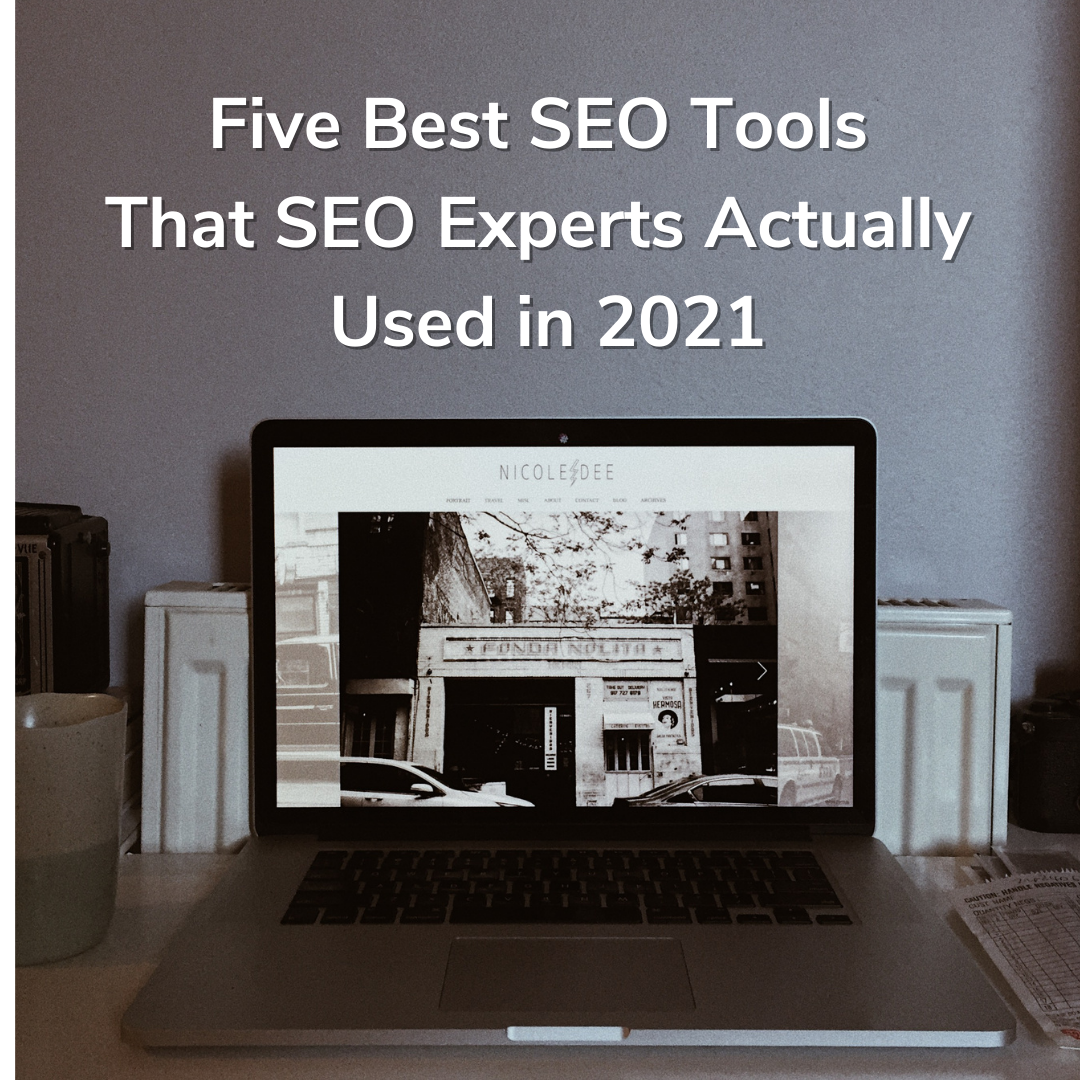What to Say, and How to Say It – Using words and images to craft your email messages.
Let me take just a minute to explain what Constant Contact is for those that may not be familiar.
Constant Contact is a do-it-yourself online marketing system. You can use it to create and manage campaigns. The company is best known for its email marketing tools. It’s easy to create and send mass email, like newsletters or announcements and updates. You can run special promotions or offers; you can build online surveys and polls to gather feedback; and you can promote and manage your events using Constant Contact with registration tools, payment acceptance, invitations– all in one place.
All of this is all built on top of a really good contact database, so that you can load all of your contacts, your customers, stakeholders, volunteers, staff, your board – whatever lists you are keeping in various spreadsheets or in your Outlook, Gmail or Yahoo folders can be loaded and organized easily in Constant Contact so that your people and your marketing campaigns are all together in one spot. Oh, and it costs most people between $20 – $75 a month to manage all of it. (Ready for a free 60 day trial? No credit card needed to take it out for a spin CLICK to sign up)
I want to give you a simple definition, or a framework, for what marketing really is.
You already know, generally, what it is – but when I say the word marketing, I mean something very specific and it’s important that we are on the same page. My definition of marketing has three simple parts –
- 1. you define an audience: a group of people that you want to target.
- 2. You reach out to them with a message that is specific to that audience. And
- 3. you elicit a physical and measurable response – which are the results that you want (and need) your business to get.
What kinds of results are we talking about?
These are examples of physical and measurable responses:
These actions represent a decision by a person to do something in response to what you put out there. It’s not a mechanical response, it is human. And it must be measurable.
But keep in mind that your overall goals come back to why you’re in business or what’s going to keep you in business……generating revenue or donations. If the responses you’re getting don’t lead in some way directly to the bottom line, then you should evaluate why you’re driving those types of responses.
Today, we are going to talk about the content you can share – whether it’s written or images – can drive the responses you need to help your business or organization.
Content is currency on the internet (and it works offline, too!)
When it comes to content, you have an advantage over big businesses and organizations, because you can use the tools and tips we’ll talk about today to have a real conversation with your customers, clients, members and volunteers. You can also use their feedback and questions to come up with new content.
- Content is what people search for, consume and share. It’s what they pay attention to.
- Through the content you email to your audience, you can become a source that your customers, clients, members and volunteers know, like and trust.
- As we progress through this presentation, think about the conversations you have with your customers or clients. What kind of questions do they ask you? How can you use those questions and conversations to create a great email?
Now, let’s tackle the big question: What kind of content should you use in your email?
Email content basically boils down to a picture, a paragraph and a call to action.
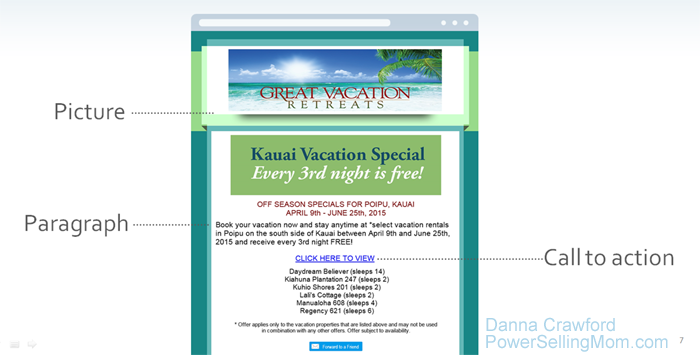
Email content is made up of the words, images and videos you use in your email campaigns that is designed to attract, convert and retain an audience. When you’re sending out an email to the people on your contact list, you want to make sure it is relevant and interesting and includes a clear call to action – meaning the response you’re seeking to solicit from your readers, whether that’s buying a product, taking your advice, signing up for services, referring you to friends, donating to your nonprofit, answering your survey, or whatever action you’re hoping they take. You can make that action easily accessible by including links to whatever you want your audience to do.
Here’s an example of an email from a company called Great Vacation Retreats. (see above) At the top of the message, they have a great picture that prominently features their brand; a text block that announces their deal, a paragraph that describes it, and a link, which is a call to action for readers to view their available vacation rentals. Even if they didn’t list the individual rentals in the email, they’d have more than enough information that communicates the action they want their audience to take – to book a rental in Kauai.
And as a bonus, the approach that Great Vacation Retreats took with this email is inherently mobile-friendly – it’s a single column template, there’s not too much text, and it’s not too long. This email will look great, no matter where the reader opens it – on mobile or on their desktop.
Remember, when you’re thinking of content that you’ll create from scratch, you’re not writing for yourself – you’re writing for your audience! So make your messages relevant, short and focused. Your email shouldn’t be telling recipients every single thing that you do, and it shouldn’t include extraneous information. You can make it relevant to your audience by thinking about the conversations you’ve had with your clients, customers and members – after an interaction, you may want to jot some ideas down that can help you expand on a topic.
I’ve mentioned relevance a few times now, and here’s why it’s important that you include content that’s for your audience, not for yourself.
- 38 percent of email recipients will unsubscribe if they think the content in your email is boring or irrelevant – and when a person unsubscribes, you won’t be able to communicate with them again.
- 32 percent will send irrelevant content to their spam folder, which could impact how email providers, like Gmail or Yahoo, sort your future messages.
- Source: https://www.marketingsherpa.com/article/chart/why-subscribers-flag-email-as-spam
Here’s what we’re going to talk about today.
- First, we’ll talk about creating content – how will you come up with ideas for the words, images and calls to action you will use in your email marketing.
- We will talk about curating content – how to find and share content from outside sources that you can use in your marketing.
- We’ll talk about extending your reach beyond your email by using social media.
- And then we will talk about how you can get started developing content ideas for your own organization.
First, let’s talk about content you create.
What do you write about in your emails? This is one of the biggest questions, and the biggest hurdles, people encounter when they set out to create an email. The good news is that you know your organization better than anyone, and there’s a world of ideas out there for you!
- First, and above all else, you write about what you know that they don’t know. This is an opportunity to share your knowledge and raise your profile as an interesting organization and an expert in your field.
- Here are some ideas of types of content you can share with your audience! Take a minute to look at what’s on the screen right now, and be thinking of ways you can explore these ideas with content about your business.
- Let’s talk about a few of them:
- OFFERINGS: If you have a new product, you can write a paragraph describing what it does, and use photos or video to share a quick product demonstration or tutorial. If you have an event coming up, send out all the details in a short email, including a link to register the event.
- UPDATES: Do you have a new location? Have you hired a new employee, or do you have a well-known employee retiring? Send out a biography and a photo to your customers and clients. Updates can go out in the form of newsletters, or even press releases. Perhaps you’re a nonprofit, and you’ve received a big grant. That’s a perfect reason to send out an email update! Did you have a recent event? Send out a survey asking recipients how it was, or send an email to share photos of the event.
- EDUCATION: You are an expert in your field. Write about what you know that your audience doesn’t. This is your opportunity to weigh in with your perspective on a study or a news story. If you sell a product, you can make a video that demonstrates how to use it. You can also share your know-how. Let’s say you own a landscaping company. You can send out an email early in the spring and lay out a good planting schedule for your clients.
- ENTERTAINMENT: Don’t be afraid to show your fun side! Have you seen a funny YouTube video that relates to your field? Or have you heard an interesting, funny or inspiring quote you want to share? Maybe you and your employees have made a cool behind-the-scenes video – that is something that could really show off your environment and personality.
Seasonal and Holiday updates work well. Is there a way you can incorporate a holiday or seasonal message? Let’s say you own a bed and breakfast at the beach – in the dead of winter, send a photo of your property under warm sunshine and ask your customers to think about planning their summer getaway. Or maybe you work in tax preparation – Thanksgiving could be a great time to let your clients know how to account for any charitable giving so they’re ready for tax season in the new year.
Let’s talk about how much content you should include in your email. Think about it… How often do you look forward to reading a long, detailed email from a business? Not very often, right? You’re looking for something concise and easy to read – what’s the news, what are the details of the deal or sale, is there any action I want or need to take? – and that’s what you should think about when you create your own emails.
- When it comes to email content, less is more. Always.
There is no rule that says your newsletter needs to have three articles, three pictures and three links. One thing is plenty. There is actually a Constant Contact customer whose newsletter is called One Thing – he did it to make it easy on himself and it works really well – people can absorb it and he’s not under the gun to come up with a bunch of content to fill it.
We did a study of our customers and found that the best practice is to limit yourself to 20 lines of text and three or fewer images. Just like you, your audience is busy. You don’t need to worry about sending a ton of information every time.
Source: Constant Contact study: https://news.constantcontact.com/research/constant-contact-data-reveals-direct-correlation-between-email-campaign-effectiveness-and-n
Our research also shows that 1 link gets the best click-through rate. You want your audience to take an action, so use a link to make that clear. Two links are OK, but once you get to three links, the click-through rate starts to decline. Any higher than 5 links means that people are LESS likely to click ANYWHERE in your email. So try to stick with only one or two clicks, and keep them high in your message so people do not have to scroll down to take an action. And don’t forget that more than half of your audience is reading email on a mobile device…who is going to scroll through 14 articles on their phone?
And for your mobile readers – make sure that you’re keeping your messages short, and your calls to action above the fold (meaning, readers don’t have to scroll down to get to your most important content).
Source: Constant Contact study: https://news.constantcontact.com/research/constant-contact-data-reveals-direct-correlation-between-email-campaign-effectiveness-and-n
Even if the idea of creating content still feels daunting, remember – keeping your messages short and focused is actually much better than putting tons of information into one email.
- You can use outlines to help you further focus your ideas and organize the sections of your email: Any text you’ll write yourself, any photos or videos you want to use, and any content from outside sources that you want to share – we’ll talk about content curation in a few minutes.
- Jot down a list of topics that come up in conversations with your customers, members, clients, volunteers or donors, and use those to spark ideas for email campaigns. If you get five questions from your clients, that’s five separate email topics you can build on!
- Show your expertise in your field – become a knowledgeable resource for your audience, and they will look forward to emails from you.
And make your messages reflect your brand – this is easy to do with email tools like Constant Contact. We won’t get into email design today, but you can visit our website for great design tips and tricks to make your emails look visually fantastic.
Let’s talk about turning your interactions with your customers, clients, members, supporters and volunteers into content for your email.
Think for a second about the last interaction you had with someone at your organization. What questions did a customer or client have? What information are people requesting about your nonprofit? Can you turn an answer to their questions into an email? Here are some great examples.
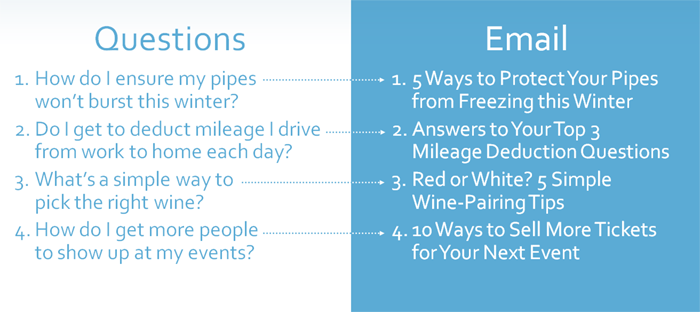
One easy way to practice this in real life is to create two columns – in a spreadsheet or document, or just on a piece of paper, with the questions you regularly get on the left. In the right column, write down a way you can turn the answers to those questions into an email full of fresh, relevant content.
I want to show you the difference between a regular email from your own Outlook, Gmail or Yahoo account, and one sent through an email service provider like Constant Contact.
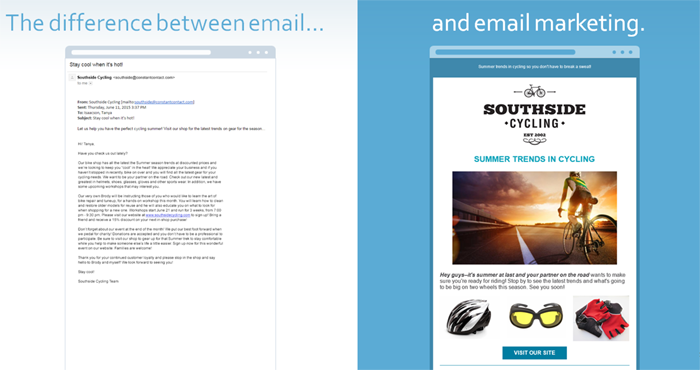
An email from a service provider looks better and gets you noticed– you can use it to feature your brand’s logo and colors, and include graphics that will capture your readers’ attention – all of this, including the graphics, comprises email content. With a combination of text and great images, you will get through to your audience. And, from a purely legal and practical perspective, an email service provider will help protect your messages from being considered spam.
Check out the email on the right (shown above) – the colors and graphics make the message eye-catching and more professional-looking than the one on the left.
As a matter of fact – and this might be a relief for those suffering from writer’s block – great content doesn’t have to be written at all!
Visual content, like photos, videos, graphics and word-images, makes a huge impact in an email inbox. Did you know that 90% of information processed by the brain is visual content and more than half of consumers believe that images are very important factor when buying? Visuals are important to your business because they influence customers’ purchasing decisions. 67% of consumers believe that images are a very important factor when selecting and purchasing a product.
You can use photos to show off your products or shots from a recent event, and you can link to videos to show your organization in action or a product demonstration. Word images – a brief phrase, statistic, or quote over a background image – are a great way to share information in an eye-catching way.
And creating visual content is easier than ever these days – almost anyone with a smartphone has the ability to shoot high-quality photos and videos. You don’t need too much time or a huge marketing budget to create compelling images anymore – you’ve got the technology right there in your pocket.
90% stat source: https://www.adweek.com/socialtimes/visual-social-media-marketing/488380?red=at
67% stat source: https://www.mdgadvertising.com/blog/its-all-about-the-images-infographic/
You’ve heard that a picture is worth 1,000 words. In your email, you can communicate through images as well as text. Turn your images into clickable links, so that when your readers click on your images, they will be directed to the action you want them to take – just make sure you also include a text link to the same location, because about 67% percent of email readers will not see images by default.
Email tools like Constant Contact make it easy to assign a URL to your images, and also to add “alt text” so that a description of the image appears, even if the reader doesn’t see the picture.
Side note – try to avoid giving too many choices in your campaign. These are supposed to be quick decisions to act (clicking to shop in your online store or selecting an item and clicking to buy) Too many choices will reduce the number of decisions / actions a person can take. It’s a time limit thing. Think of your campaign as window shopping. You want to entice someone to come in right then and buy because of whatever got their attention.
When you’re using images in your marketing, you’re faced with the task of creating that content, deciding what images are best, and determining their context and the story around them. That’s a lot to think about, and you’re probably wondering where to begin. Here’s some direction.
- Images can be created around:
- Your business
- Your environment and what’s around you
- Your expertise
- Themes that you decide your audience will love
You don’t have to have a product to sell to include visual content in your emails! If you have a new employee, feature their photo with a caption explaining who they are and what they’ll bring to your business. If you’re a nonprofit, share photos of a recent event, or a graphic showing the progress of a fundraising campaign.
Photos are a frequent and necessary piece for visual content. Sometimes, you may find you need a photo that you do not have or cannot create on your own. There are a variety of online stock photo sites where you can search for just the right photo that fits your needs. They are a great resource and can work well for visual content that’s based around a theme, a tip, a fact or a quote.
When you download a photo, be sure it is the right size or slightly larger! You can always crop it or scale it down, but will lose image quality if you try to enlarge a small image too much.
It might be tempting, but it’s never a good idea to use just any image you may find through a search, including sample stock photos with a watermark on them.
There can be copyright issues associated with those images; they belong to someone else. When using stock photos, you purchase the rights to use the photo, or in some cases accept a free download and agree to certain credit/conditions. Fees can vary, so shop around for what feels right for you and fits your budget. Here are some services that you can use to get free stock photos!
Constant Contact customers have access to over 12 million images through BigStock. But even if you aren’t a customer, BigStock offers a free trial for new users.
- BigStock: https://www.bigstockphoto.com
- StockVault.net https://www.stockvault.net/
- FreeImages.com https://www.freeimages.com/
- FreeDigitalPhotos.net https://www.freedigitalphotos.net/
Video is a powerful way to engage with your audience. People prefer watching a video to reading long web pages full of text.
- When using video, make sure you mention in your subject line that your email includes a video, so your readers know about it right away.
- Consumers prefer watching a video to reading long text articles. In fact, 50% of people are more likely to read emails that include a video.
- But make sure the length of your video is within 90 seconds– that’s the point at which 58% of viewers will stop watching.
- You can make video work for your business – use it to show product demos, customer testimonials, promotional material or share user-generated content.
We’re talking about email today, but video is becoming very prominent on social media – 84% of consumers have liked videos from companies in their social media news feeds. If you email a video link, you can also repurpose it on your social media platforms for that audience to watch and share.
The example here is a great way to use video – The Pajama Program sent this email out with a link to a video thanking their donors.
Just remember to keep videos short – we’ve said it a few times already, but your audience is very busy. Videos should be about 90 seconds or less.
Make sure you’re using video in a careful, deliberate way. If you have some specific action that you want your readers to take – for example, to register for an event – you should choose text and pictures, rather than video. Using a video in that case will lessen the likelihood that your readers will take the action, because they will click on the video and be taken over to YouTube.
- Source: Consumers are 50% more likely to read emails that include video, Animoto, the 2015 Video https://www.adweek.com/socialtimes/infographic-animoto-online-video-smbs/619908
- Source: Length (average viewing is 90 seconds) https://www.mediabistro.com/alltwitter/digital-marketing-stats_b48214
- Source: 84% have liked videos in their feeds: https://www.adweek.com/socialtimes/infographic-animoto-online-video-smbs/619908
Now, let’s talk about curating content – finding and distributing content that is relevant, educational, entertaining and newsworthy.
At this point, you might be feeling overwhelmed, thinking you have to think up infinite ideas to create content from scratch. That’s not the case at all! We know you don’t have any time to spare in the operation of your small organization. The great news is that you can curate content – meaning that you can find content created by others and share it with your email contacts.
Think about a curator at an art museum. That person uses their expertise to collect and present artwork from many different sources and arrange them in a way that’s educational and organized – they’re not responsible for painting every canvas!
Your curated content could be a link to a news article related to your organization, with a brief paragraph including your perspective. The example on your screen is of a cycling company sharing their favorite headlines in cycling news for a weekly newsletter. All they had to do was write a brief introduction and then link to the articles.
Your audience will come to rely on you as an expert in your field. Let’s say you run an animal shelter, and you come across an article about coyotes in your area. You can introduce that link by giving some helpful tips for pet owners to keep their dogs and cats safe.
Or maybe you own a restaurant, and a new food trend has been talked about in the national media – you can link to a video from a TV station and tell your contacts how you’ve added some trendy items to your menu.
There are lots of different places online where you can find content to share through your emails.
- Read your local and regional news – maybe you’ve been mentioned, or maybe you have something to say about goings-on in your community. A lot of news sites offer their recent content for free. Just make sure that if you link to content on a news site, it’s not something you need a subscription to read.
- You can read blogs related to your field – one way to easily gather lots of blog posts is through Feedly – a service that aggregates blogs from all over. You can customize a Feedly account by selecting the areas you’re interested in reading about. It’s a great way to find content you’ll share with your contacts.
- You should follow others on social media! This is a world of almost infinite possibilities. Let’s go back to that animal shelter example – they would want to follow other shelters, the ASPCA, pet retailers and other animal advocacy groups, and share content from those sources.
- Set up Google Alerts – Google will aggregate pages that mention a phrase you’ve created an alert for. You should definitely set one using your organization’s name to keep an eye on what people are saying about you online.
- Subscribe to other email lists! This is a great way to get ideas for content and see what other people are sharing.
- And finally, you should always provide links to the original source, and let people know why you’re sharing the content.
Some people have asked whether it’s plagiarism to share content by other people – and the answer is definitely not! As long as you cite your source, you can share what’s publicly available. You’re actually helping the source broaden their audience by sharing their content with your audience. The difference between sharing and plagiarism is citing the source. If you were to copy and paste someone’s blog post, and pass it off as your own without mentioning the source, you’d be plagiarizing. Always give credit where credit is due!
One way to get creative and great content to easily share via email, and on social media, is to have others create it for you!
You can do that through sharing behind-the-scenes videos or photos, like this one from The Avenue Gallery, showing one of its employees loading a painting to be transported.
You can also use client or customer testimonials. There are a few ways you can approach these – you can ask a client to share their story on a video, or write a paragraph about their experience. Or, if you have a place on your website for reviews, you can pull content right from those reviews!
You can also compile user-generated content. This Facebook post from the Wekiva Falls RV park shares photos from a customer who documented her recent visit. One way to inspire user-generated content is to create a hashtag – a hashtag is a word or phrase beginning with a pound sign, or hash sign, that creates a link connecting all of the posts using that hashtag on a particular social network. You can create your own hashtag by coming up with a unique word or phrase, or even your brand name: Make sure you keep it short, and don’t use any spaces or punctuation – just letters and numbers. For example, here at Constant Contact, our employees use #CTCTlife to share pictures and videos of our company culture. Once you’ve created a hashtag, ask your customers, clients, members, employees and volunteers to create social media posts with that hashtag – then you can select your favorites to share!
Now we’re going to talk about how you can extend your reach beyond your email audience.
Once you’ve decided what content you’re going to use in your communications, it’s time to share it! This way, you extend your reach as much as possible. Using email is one way to share content, but you can also share it through social media. Email marketing tools like Constant Contact make it easy for you to share your content on different social platforms, and also for your audience to share your content across THEIR social platforms.
When you’re thinking of content to use on social media, you don’t have to reinvent the wheel! You can use the content you’ve already sent in your email, and break it into smaller pieces of social media content.
Don’t worry – this isn’t going to translate into a lot of extra work for you. You’re already building out content for the future as you focus on your emails.
For example, let’s say you’re a marketing consultant for businesses that run a lot of events, and you’ve sent an email to your those clients with four tips about selling more tickets for their events. We’ll call that your original email. Next let’s quickly think of a few ways to extend the content by expanding on each tip as its very own social media post!
- The tip on sending your invitations in advance could be expanded to a Facebook post about when to send your event invitations.
- Hanging flyers in your store could be turned into a great info-graphic on effective flyer design that you share across all your social networks.
- Advice to post events on Facebook could expand to a blog post on promoting events on Facebook, which you can share across all your social networks.
- And a tip about special pricing for VIPS could be repurposed into five Tweets (spread across a week) about the things VIPs want.
Here is an example of a company, the Grafton Inn in Vermont, repurposing content. 1) They used this image of a porch swing in their email, which announced summer activities at the inn. 2) They repurposed the photo on Facebook to show their weekly schedule. 3) And on Instagram, they shared it with their followers with a cute caption. (see below)
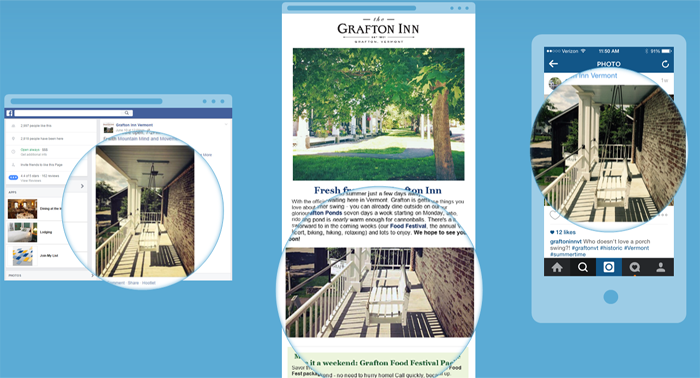
You can do the same thing. Take a tip, a quote, an image or anything that your audience will find interesting and share it on whatever social networks you use.
Now, do keep a few things in mind. First: Change the content a little bit for each network. And I’m not just talking about its size. Change the caption or text in the post to reflect the style, etiquette and voice for each network. Don’t post exactly the same thing in each place.
Next: Don’t worry about being repetitive. People are following you because they like you. They might miss your post on Facebook, but catch it later on Pinterest. Or they might follow you on Pinterest and not Facebook, so you need to make sure you’re covering all the places people might be seeing your content.
Finally: While we’re talking about using multiple social networks, keep in mind that you don’t have to use all of them for your business. Just choose the ones that are right for you and your audience. It’s better to focus on a couple of social networks and do a good job with them than to have a bunch that you don’t have time for and manage poorly.
When it comes to extending your reach, you want to make sure that you’re meeting your audience where they are. Email is a great place to start, but you can reach more people by sharing your email content on all of your social media platforms. Think about it this way – there is probably some overlap between your email contact list and your followers on social media, but those groups are not likely to be identical. Also, what your followers do on social media, THEIR followers see. If someone likes or comments on your post on Facebook, all of their friends will see that, and see your name.
Marketing on social media tends to be less expensive than traditional advertising. If cost is an issue, you’ll get more return on your time, money and energy by going first through email and subsequently through Facebook, LinkedIn, Twitter, etc. Each has its own typical audience and decision process. You want to start on the social networks you already use, and then begin to move to where your customers and contacts are so that you can leverage the existing network you have on those sites and begin to generate some social visibility along the way.
To be clear, email IS part of social media.
And if you’re doing it right, keeping your messages short, making the action or response obvious and simple and providing access, information and real value, then you will grow your business.
The best part of this is, if you’re a Constant Contact customer, we make sharing your emails on social media really easy!
- If you are using Constant Contact, add the Share Bar to the top of your emails – this allows your readers to post a link to your email on their social media profiles
- And add social media buttons that link to your business’ social media profiles. The buttons are a nice visual reminder for them to click and follow you online.
- Remind your audience to share your promotions – ask them to Like them on Facebook, retweet on Twitter or pin on Pinterest
Your audience has a lot of influence via word of mouth, and you can get your promotions in front of more people – their friends and family – if they help spread the word for you
SOURCE: Visualistan, Latest Social Media Statistics Infographic https://www.visualistan.com/2015/04/latest-social-media-statistics-infographic.html
SOURCE: VPNMentor https://www.vpnmentor.com/blog/vital-internet-trends/
Constant Contact allows you to extend the reach of your emails by using the Social Share tool.
- Social Share offers a quick and easy way to share an email on Facebook, Twitter and LinkedIn with suggested post messages, images, and the best times to schedule posts based on when your social audience is most active. It also makes it easy to plan social posts for an email with a monthly calendar.
Now, let’s talk about the next steps you can take.
Remember, when you’re thinking of content that you’ll create from scratch, you’re not writing for yourself – you’re writing for your audience! So, use links to direct your audience where you want them to go, and make your messages relevant, short and focused, with the call to action very clear.
It can be very helpful to keep a calendar to schedule emails and social media posts ahead of time. Keep that running list of topics that come up in your organization, and plan out your publishing schedule in whatever way that works best for you. There are no hard and fast rules about how you should schedule – just make sure whatever you do is realistic for you to follow, whether you use an Outlook calendar, a Google Doc, a notes app on your mobile device, or a hand-written schedule, or anything else that keeps you organized!
If you’re using an email marketing service like Constant Contact, you can track which types of content get the most clicks and opens, and use that information as a guide for future emails.
You can also, from time to time, send out a survey asking your audience what types of content they’d prefer to receive from you.
In the beginning of this presentation, I said that email content boils down to a picture, a paragraph and a call to action. You can use this as a really basic outline to create content for any subject you think of.
- Take the last question you answered for a customer, client, member, donor or volunteer, and develop an email around it using a picture, a paragraph and a call to action.
Let’s go back to our first example, about the vacations in Hawaii, and say our customer question is: “What offers are available for renting in Kauai?”
- First, the picture: Remember – 90% of information absorbed by the brain is visual, so how can you illustrate the subject to catch your reader’s attention? Don’t forget, you can use stock photography, and you don’t need to be selling a product to use visuals. This photo of a beautiful seaside cliff in Hawaii grabs the reader and makes her want to learn more about seeing it in person.
- Next: What is it that you need to write? Respond to that last question you were asked. Your paragraph can be just a few words introducing a link, a longer explanation about the subject, or tips to answer the question in a few steps. In the example, the paragraph explains that rentals are available, and that every third night is free.
- Finally, you need a call to action: What do you want your audience to DO in reaction to your email? Come to your business for a consultation, buy a product, register for an event, or donate… make your call to action prominent and clear. Here, the call to action is a link, where readers can go to the vacation company’s website and see – then hopefully reserve – the available rentals in Kauai.
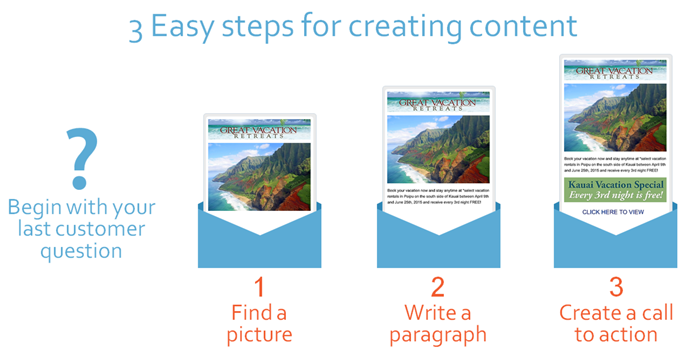
Let’s go over a few more examples:
B2C: Let’s say I own a wine shop, and I’m getting a lot of questions about what foods to prepare with rose wine. I can take a photo of a beautiful glass of rose with a meal, or of a display in my store. After that, I can write 5 tips for pairing different foods with rose wines (I can even include links to recipes if I’m feeling really crafty), and finally, as my call to action, I can include a coupon for 20% off selected types of rose.
B2B: I own a marketing company. One of my clients has asked me about how often she should be posting to Facebook, Pinterest, Instagram and Twitter. I can use a word image [a picture with words laid over it] to easily list the different platforms and the best practices for frequency, or I could use a cool infographic with that information. That’s my image. Then, I could write a few sentences explaining that I’ve written a blog on the subject, and include a link to the blog post – that is my paragraph AND my call to action!
Nonprofit: I’m the president of a local conservation group and a resident has written to ask about the progress of a river cleanup project my group is working on. I can include before and after photos of an area that was cleaned up, a paragraph describing what is going to happen next, and links for my audience to donate or volunteer – my calls to action.
From there, you can repurpose the email content by breaking the subjects down even further into posts onto the social media platforms!
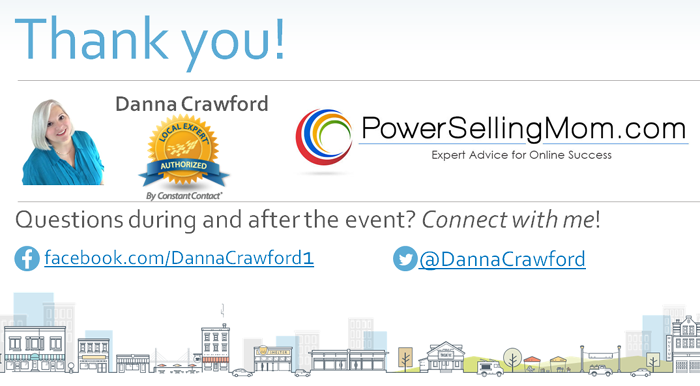
Watch the replay :
. Source: The above contact is provided by Constant Contact. I’m using as an authorized local expert trained by Constant Contact. Feel free to contact me should you have any questions. If you are already a user of Constant Contact and are not part of the PowerSellingMom.com network, send me an email saying : Yes, Danna Crawford, I want to be a part of the PowerSellingMom Constant Contact network. Include your Constant Contact user ID and email. Send to: DannaCrawford@gmail.com
Thank you for allowing me to share my personal email marketing tips in addition to the presentation. NEED MORE assistance, I am here for you. CLICK TO VIEW additional training/coaching. Or sign up for the WEBINAR NEWSLETTER to receive updates and invites to future webinars.


